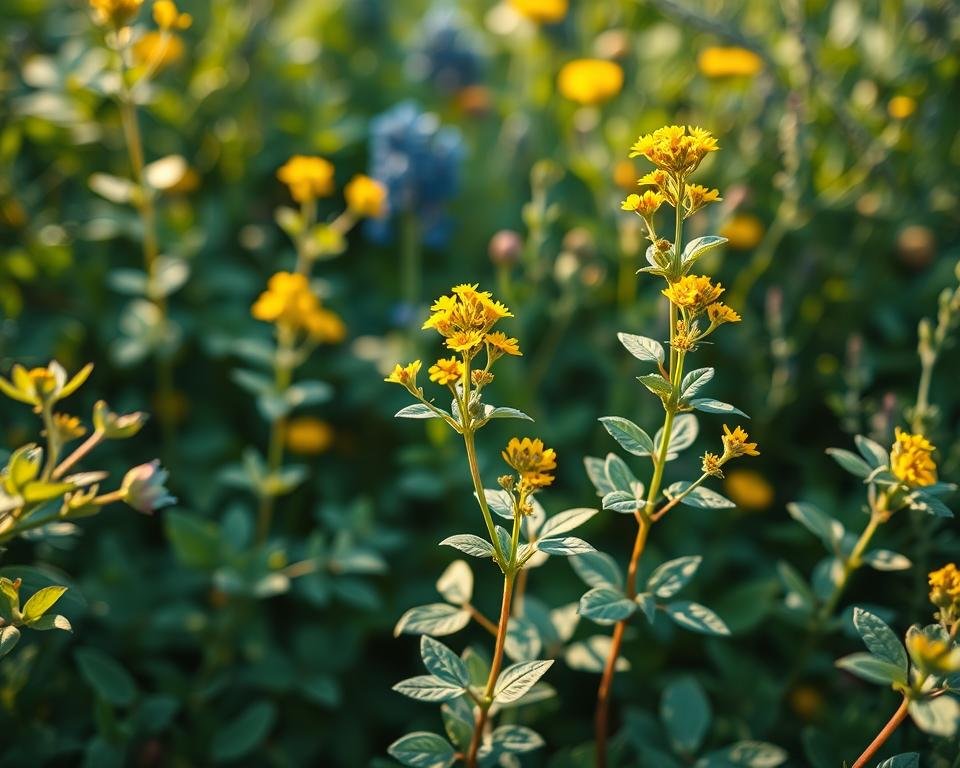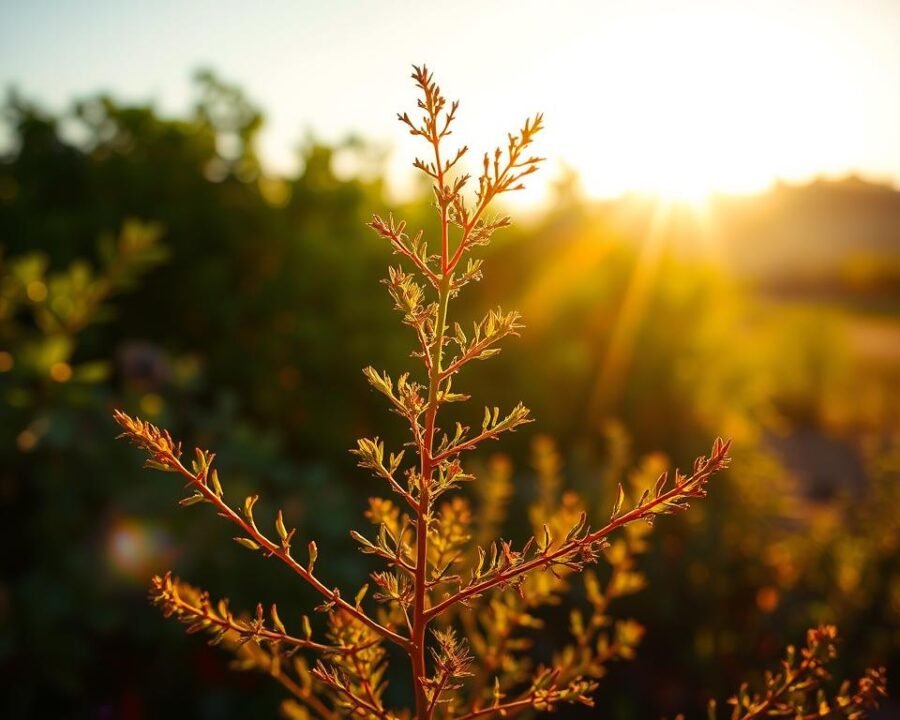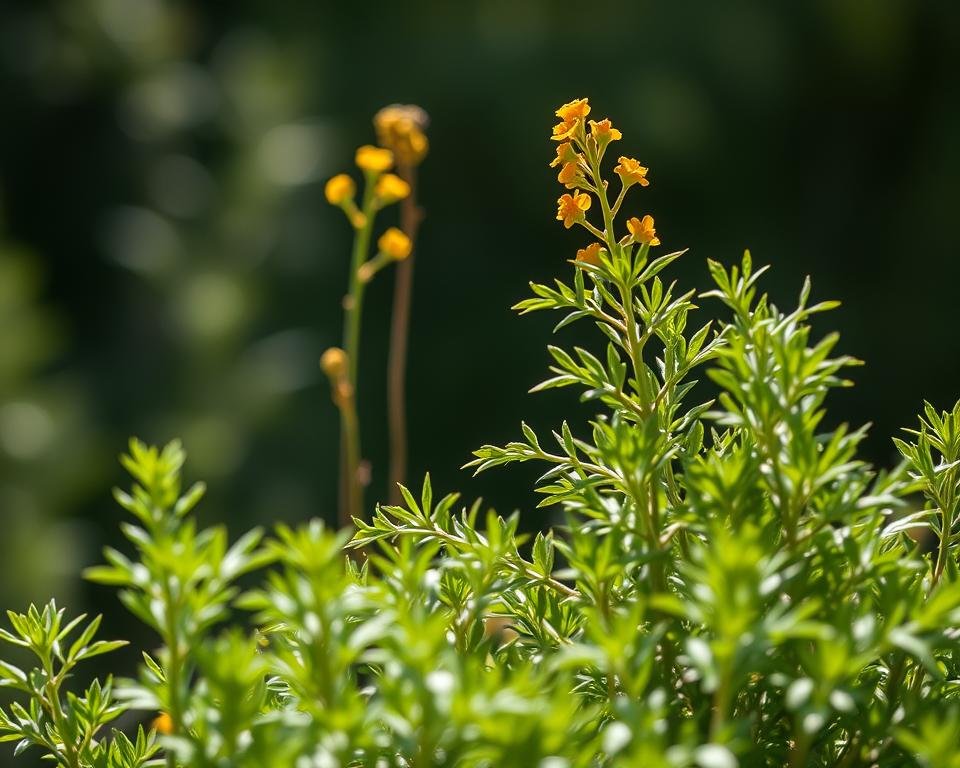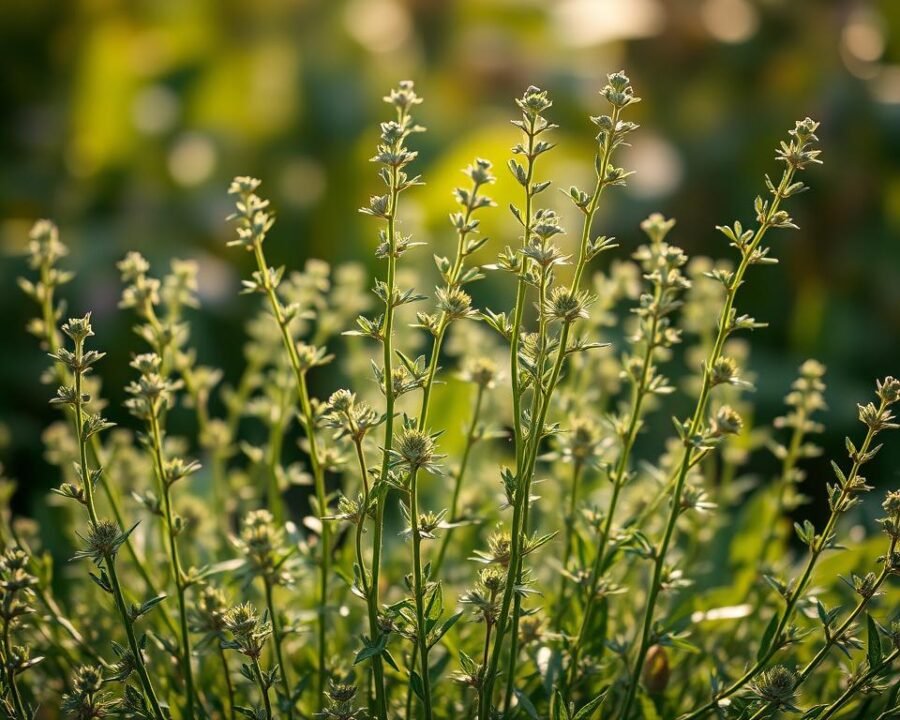Have you ever walked through a garden and noticed a striking, blue-green plant with delicate yellow flowers? That’s likely rue, a timeless favorite among gardeners. With its rich history and modern appeal, this versatile herb brings both beauty and function to any space.
Known for its resilience, rue thrives in dry conditions and even repels pests naturally. Its unique foliage adds texture to landscapes, while its blooms attract pollinators. Whether you’re a seasoned gardener or just starting, we’ll guide you through everything you need to cultivate this remarkable plant.
Key Takeaways
- Rue is a drought-tolerant, low-maintenance herb.
- It serves as a natural pest deterrent and pollinator magnet.
- The plant features striking blue-green leaves and yellow flowers.
- Both ornamental and practical, it fits well in diverse gardens.
- Proper handling is essential due to its mild skin sensitivity risk.
Introduction to Rue Herb Plants
The *common rue* (Ruta graveolens) has fascinated cultures for centuries with its dual beauty and utility. This perennial herb boasts blue-green *leaves* and clusters of yellow flowers, reaching 2–3 feet tall. Its musk-like scent and clumping growth make it a striking addition to any *garden*.
A Plant Steeped in History
Native to Southern Europe, *Ruta graveolens* was cultivated as early as the 16th century. Romans used it for spiritual protection, while Jewish traditions incorporated it into Yom Kippur rituals. Over time, its role shifted from medicinal *herb grace* to an ornamental favorite.
Cultural and Practical Notes
Despite its charm, handle with care:
- Toxic: Can cause skin irritation similar to poison ivy.
- Wildlife ally: Host plant for swallowtail butterflies.
- Adaptable: Thrives in full *sun* and tolerates wide *temperatures* (Zones 4–10).
Why Grow Rue? Benefits and Uses
Beyond its striking appearance, rue offers a wealth of benefits for gardens and homes. This resilient plant serves as a natural pest deterrent, pollinator hub, and even a historical remedy. Let’s explore its multifaceted roles.

Medicinal and Culinary Applications
Historically valued as a medicinal herb, rue contains rutin, an antioxidant linked to relieving arthritis and headaches. However, caution is key—it’s toxic if ingested in large quantities and unsafe for pregnant women.
Modern culinary uses are rare due to its bitterness, but dried leaves add depth to oils or vinegars in tiny amounts. Always consult an expert before internal use.
Garden Ally: Pollinators and Pest Control
Rue’s bright yellow flowers attract swallowtail butterflies and bees, boosting biodiversity. As a companion planting champion, it repels deer, rabbits, and onion flies while protecting roses and raspberries.
Avoid pairing rue with:
- Tomatoes (stunts growth)
- Basil or cabbage (competes for nutrients)
Dried leaves also shine in sachets to ward off fleas or as rustic accents in floral arrangements. Whether for utility or beauty, rue earns its place in any garden.
How to Grow Rue Herb Plant Everyone Is Using
Success with this hardy plant hinges on sunlight, soil, and spacing. Whether you’re starting from seeds or cuttings, these foundational steps ensure robust growth.
Choosing the Right Location
Rue thrives in full sun—aim for 6+ hours daily. While it tolerates partial shade, expect fewer blooms. Southern exposures or rocky outcrops mimic its native Mediterranean habitat.

Preparing the Soil
Well-draining, alkaline soil is ideal. If your ground is heavy clay, mix in sand or lime to improve drainage and pH (target 6.5–7.5). For containers, use a cactus blend with perlite.
Planting Seeds or Cuttings
Sow seeds 0.5–1 cm deep in early spring. Germination takes 2–4 weeks at 70°F. Space seedlings 12–24 inches apart—rue spreads aggressively if unchecked.
- Transplant tips: Harden off seedlings for 7 days before moving outdoors.
- Containers: Use pots with drainage holes to curb self-seeding.
- Cuttings: Snip 4-inch stems in summer, dip in rooting hormone, and plant in sandy mix.
Note: Wear gloves when handling; sap may irritate skin. Monitor for volunteer sprouts—rue reseeds readily!
Caring for Your Rue Plant
Keeping your rue thriving requires simple but strategic care. This resilient beauty rewards attention with lush growth and vibrant blooms. Let’s break down the essentials.
Watering and Sunlight Needs
Rue’s drought tolerance means less water—only when the top 2 inches of soil dry out. Overwatering invites root rot, so ensure pots or beds drain well.

Full sun (6+ hours daily) keeps it compact and floriferous. In hotter climates, afternoon shade prevents leaf scorch. Watch for wilting or yellow leaves—they signal a problem.
Fertilizing and Pruning
Feed sparingly with a 10-10-10 formula in *early spring*. Too much nitrogen encourages leggy growth. For bushier plants, pruning is key:
- Trim to 6–8 inches in *early spring* to stimulate new stems.
- Deadhead spent flowers to prevent aggressive self-seeding.
- Snip damaged leaves to improve airflow and deter pests.
“Rue thrives on neglect—but a little love ensures it stays picture-perfect.”
Leggy stems? Cut them back by half. Sparse blooms? Check sunlight exposure. With these tweaks, your rue will flourish effortlessly.
Propagating Rue for More Plants
Expanding your garden with more rue plants is easier than you might think. Whether you prefer starting from seeds or cloning with cuttings, both methods deliver robust results. Below, we break down the steps and timing for each approach.
Growing from Seeds
Collect dried seed pods in fall for spring planting. Cold stratification boosts germination—refrigerate seeds for 1–2 weeks before sowing. Plant them 0.5 inches deep in well-draining soil. Keep the soil moist until seedlings emerge in 14–28 days.
Using Stem Cuttings
Take 4–6 inch semi-hardwood cuttings in summer. Dip the ends in rooting hormone and plant in a sand-perlite mix. Cover with a humidity dome to retain moisture. Roots typically form in 3–4 weeks.
| Method | Success Rate | Best Time | Key Tip |
|---|---|---|---|
| Seeds | 70–80% | Early spring | Cold stratify for faster germination |
| Cuttings | 85–90% | Summer | Use rooting hormone for stronger roots |
After propagation, harden off new plants by gradually exposing them to outdoor conditions over 7 days. For container-grown rue, move pots indoors before frost. A sunny windowsill keeps young herbs thriving through winter.
Harvesting and Storing Rue
Timing is everything when collecting rue for long-term storage. The leaves hold the highest concentration of oils just before flowering, typically in late spring. Follow these steps to preserve their potency and extend their use.
When and How to Harvest
Choose a dry morning after dew evaporates. Wear gloves to avoid skin irritation, especially on sunny days. Snip stems 4–6 inches long, leaving ⅓ of the plant intact to encourage regrowth.
For continuous harvests:
- Prioritize young, tender leaves for culinary or medicinal purposes.
- Cut older stems for drying or decorative garden projects.
- Avoid harvesting after frost, as cold damages oil content.
Drying and Storing Leaves
Bundle 5–7 stems with twine and hang upside-down in a dark, ventilated area. Air-drying takes 2–3 weeks; a dehydrator speeds this to 6–8 hours at 95°F.
Storage options include:
- Airtight jars: Keeps dried leaves fresh for 12–18 months.
- Fabric sachets: Repels moths or fleas in closets.
- Wreaths: Adds rustic charm to doors or walls.
“Rue’s versatility shines when stored properly—whether for practicality or decoration.”
Safety Precautions When Handling Rue
While rue offers many benefits, it requires careful handling. Its natural compounds can cause reactions in both people and pets. With simple precautions, you can enjoy this plant safely while avoiding common problems.
Understanding Skin and Sun Sensitivity
Rue contains oils that may irritate skin, especially when exposed to sunlight. Reactions range from mild redness to blistering, similar to poison ivy. Those with sensitive skin should take extra care.
Key protective measures include:
- Wearing gloves, long sleeves, and goggles when pruning
- Working with rue on cloudy days or in early morning/late afternoon
- Washing hands thoroughly after contact
Keeping Pets and Family Safe
The plant’s toxicity extends to animals. Ingestion may cause vomiting, diarrhea, or lethargy in pets. Children should be supervised near rue plantings.
For safe gardening:
- Plant rue away from play areas and pet zones
- Dispose of trimmings in sealed bags
- Store dried leaves out of reach
| Exposure Type | Symptoms | First Aid |
|---|---|---|
| Skin contact | Redness, itching | Wash with soap, avoid sun |
| Ingestion | Nausea, dizziness | Seek medical help |
| Eye contact | Burning sensation | Flush with water |
For severe reactions, contact poison control or a veterinarian immediately. More safety information is available from medical sources.
“Respect rue’s protective qualities—with proper handling, it remains a garden treasure.”
In pots, rue can be placed on high shelves or patios to limit access. Always label containers clearly if sharing plants with others. These simple steps help prevent accidents while enjoying rue’s unique qualities.
Conclusion
Few plants blend beauty and utility as seamlessly as rue does. Its low-maintenance nature and multi-season appeal make it a garden gem. Remember to wear gloves when handling—safety first!
Support swallowtail butterflies by letting rue flourish. Pair it with roses or raspberries for natural pest control. Avoid tomatoes or basil nearby.
Ready to try? Share your garden successes or questions below. Happy planting with these versatile herbs!
